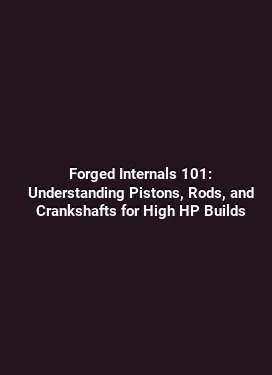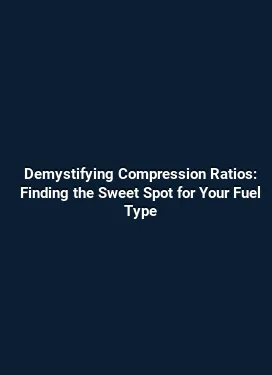How to Choose Right Turbo Size for 500HP BMW N54 Engine Build
Understanding Power Targets, Flow, and Accessibility in a N54 Platform

Building toward a 500 horsepower goal on a BMW N54 involves balancing multiple interdependent variables, including turbine and compressor housing sizes, compressor map characteristics, and how the engine breathes at higher RPMs. A successful combination delivers not only peak horsepower but also usable torque with consistent spool, linear boost delivery, and reliable operation across your intended driving range. When evaluating options, start by clarifying the drivetrain behavior you want—street manners with strong midrange or track-focused performance with rapid spool. The N54 platform excels when the turbo pairing respects the engine’s fueling strategy, intake and exhaust flow, and the cooling capacity of the intercooler and charge air system.
In practical terms, a 500HP target on a relatively stock block means you need a turbo setup capable of delivering substantial airflow without excessive compressor surge or lag. Fundamental relationships come into play: as airflow increases, so do the demands on the exhaust side, cooling system, and fuel system. The chosen turbo must align with the N54’s valve timing, cylinder compression, and intake plenums to maintain reliable combustion stability at elevated boost levels. A well-planned system also anticipates drivetrain stress, including transmission and differential capabilities, to ensure the power is useable and repeatable on a variety of road surfaces and track conditions.
Key concepts that influence turbo choice

First, consider the desired spool speed. Smaller turbochargers tend to spool earlier, delivering boost sooner but limiting peak flow. Larger units move the boost onset later and require higher exhaust energy to reach similar peak pressures. The balance between spool and top-end flow is crucial for a comfortable daily driver that still satisfies a 500 horsepower objective. Second, assess compressor and turbine maps in relation to the engine’s natural breathing characteristics. A compressor with a suitable pressure ratio and efficiency curve paired with a turbine that supports the expected exhaust energy will minimize lag and maximize responsiveness. Finally, factor in intercooling capacity, charge air cooling strategy, and fuel delivery all the way through the calibration phase to ensure the engine can sustain the intended boost without detonation or misfire.
Turbo Sizing Fundamentals for the N54
The N54 responds well to turbo configurations that preserve efficient airflow without creating excessive heat or pressure drop across the intake and exhaust paths. When sizing a turbo for 500 horsepower, two main measurements guide the decision: the compressor map and the turbine map. The compressor map reveals how the compressor will perform at different boost pressures and mass flow rates. The turbine map indicates whether the exhaust energy at those flow rates can drive the turbine to the desired speed. A commonly used approach is to select a pair that sits near the peak efficiency islands at the target mass flow, ensuring the compressor can maintain stable airflow across RPM ranges while the turbine has enough energy to accelerate quickly.
Additionally, the relationship between turbine housing size and exhaust energy must be carefully matched to the engine’s exhaust manifold design and overall exhaust flow. A housing that’s too small raises backpressure and reduces top-end flow, whereas an excessively large housing can impede spooling and drive pressure loss. In practical terms, your selection should align with a realistic boost target, typically in the range suitable for a 500HP N54 build, a robust intercooling plan, and fuel system upgrades capable of supporting the higher air mass at peak power.
Load events, boost control, and driveability
Boost control strategy is a critical thread in the sizing decision. A well-tuned system maintains stable boost rise and fall, with predictable torque curves across gears. The control method—whether map-based, PWM, or a hybrid approach—must be capable of responding to load changes without causing surge or boost overshoot. Additionally, the intercooler layout and charge piping impact how quickly air is cooled and how much pressure drop occurs from compressor discharge to the intake valve. For a 500HP target, ensuring efficient charge cooling and minimal pressure drop helps the turbo reach its intended performance band without compromising reliability.
Practical Component Pairing for a 500HP N54 Build
Beyond the turbo sizing itself, other components play a pivotal role in achieving a reliable 500 horsepower. Fuel system upgrades—injectors with appropriate flow, a high-capacity fuel pump, and precise fueling calibration—enable the engine to sustain high boost levels. An upgraded intake system and a well-matched exhaust setup assist in efficient volumetric flow, reducing heat soak and improving response. The intercooler selection is equally important; a core with sufficient surface area and optimized airflow reduces intake air temperatures, which supports consistent combustion and higher timing margins. Finally, the engine management strategy must be tuned for the unique characteristics of the chosen turbo, with particular attention to knock protection, ignition timing, and fueling across the RPM spectrum.
When selecting a compressor for 500HP on the N54, some common practice favors a ball-bearing design that reduces friction losses and enhances throttle response. The turbine housing might range from a precision-fit package that emphasizes fast spool to a larger, more robust housing that sustains high boost at elevated RPM. The ideal pairing should produce rapid spool in the lower-mid range while delivering ample mass flow for top-end power, all with a comfortable margin of reliability under continuous track or highway use.
Intercooling, Intake, and Charge Air Management
Charge air cooling is a major determinant of the final usable power. An efficient intercooler lowers intake air temperatures, increasing air density and allowing more ignition timing and higher boost without compromising reliability. The plumbing should minimize smooth bends and lengthen charged air paths to avoid hot spots. In the N54, where intake routing and cylinder head design influence flow, a carefully engineered intercooler and pipe routing prevent heat soak and promote consistent performance during repeated high-load cycles. When the turbo size is chosen, ensure the cooling system has the capacity to sustain cooler air under sustained boost, particularly on longer drives or track sessions.
Regarding intake, a properly sized intake plenum and optimized throttle body compatibility help maintain smooth air delivery to the cylinders. A mismatch here can erode the benefits of the turbo choice, creating uneven torque delivery or subtle throttle response issues. In practice, pairing a mid-sized compressor with a balanced plenum architecture tends to deliver a strong, linear feel in the midrange without sacrificing top-end capability.
Boost Control, Vectors, and Calibration Nuances
Calibration is the bridge between hardware and real-world performance. A 500HP build demands an ECU strategy that respects both mechanical limits and safety margins. Boost targets should be set with caution, gradually increased during dyno calibration to monitor knock, air-fuel ratios, and ignition timing. A staged approach—baseline fueling with incremental boost steps—helps verify that fuel delivery, ignition advance, and boost control are harmonized. Real-world testing should include WOT (wide-open throttle) pulls at various gears and speeds to assess spool consistency, boost stability, and torque delivery across the usable RPM range.
Another calibration nuance is the interaction between turbo spool characteristics and drivetrain behavior. A turbo that spools aggressively might highlight traction issues or drivetrain stress in high-tload launches. In such cases, adjustments to torque management strategies, launch control, and differential behavior can preserve reliability while preserving performance. The goal is to maintain a predictable power response that matches the driver’s expectations in both street and track environments.
Reliability, Heat Management, and Longevity Considerations
High-horsepower builds impose heat and stress on components that were designed for much lower power levels. Implementing robust cooling, using durable bearings, and ensuring high-quality seals throughout the turbo and charge system contribute to long-term reliability. It is prudent to consider turbine efficiency and thermal efficiency under sustained loads to avoid rapid wear. A well-chosen turbo with an appropriate turbine housing and compressor design, complemented by a capable intercooler and proper oiling strategy for turbo bearings, can deliver consistent performance across dozens of dyno pulls and spirited road sessions without excessive heat buildup.
Oil and coolant routing should be revisited to accommodate the increased thermal load. A dedicated oil supply for the turbo, along with a return flow design that prevents oil pooling, helps extend bearing life. Similarly, a robust coolant loop around the turbocharger helps maintain consistent temperatures during aggressive use, reducing the risk of thermal throttling and detonation tendencies. These choices collectively influence the durability of the entire forced-induction system and the engine itself.
Testing, Validation, and Real-World Driving Scenarios
After selecting the turbo size and upgrading supporting components, rigorous testing validates the build. A phased testing plan begins with static measurements and bench-dyno runs to characterize airflow, boost response, and fuel delivery. Subsequent on-vehicle testing checks spool time, turbo lag perception, and driveability at various speeds, including urban stop-and-go conditions and highway accelerations. On-track assessment further reveals how the setup handles sustained high-load sessions, heat management, and thermal stability of intake charge. Data logging during each phase is essential, enabling the tuner to tune timing, fueling, and boost control with precision.
During testing, monitor for signs of compressor surge, exhaust backpressure, temperature spikes, or fuel pressure drops. If any of these occur, revisit the turbo sizing pairing, adjust the boost curve, or enhance cooling capacity to preserve reliability. The end goal is a setup that delivers measurable horsepower gains without compromising drivability or longevity, ensuring the 500HP target is not only achievable but repeatable under real-world conditions.
Case Studies: Practical Scenarios for 500HP Targets
Consider a scenario where a mid-sized twin-scroll setup is chosen to deliver boost quickly and maintain a broad usable range. In this case, matching a compressor with a high efficiency at mid-boost and a turbine housing that can sustain the same flow rate at higher RPM helps minimize lag and maximize top-end power. The fuel system is upgraded with high-flow injectors and a slang-free feed, while the intercooler remains compact with high charge-air density. This combination typically delivers a smooth torque curve suitable for street driving and a competitive track performance profile.
Another scenario might involve a larger single turbo aimed at significant top-end gains. While spool may be slower, the system can sustain higher mass flow at elevated RPMs, translating into higher peak horsepower. To keep driveability intact, this approach commonly relies on precise fuel mapping, timing strategies, and an intercooler capable of handling higher heat loads. In both scenarios, the emphasis remains on reliable operation, robust fueling, and consistent power delivery across gears and speeds.
Final Guidance for Builders and Enthusiasts
Choosing the right turbo size for a 500HP BMW N54 build requires a holistic view of the entire forced-induction system. Start with a clear power target and a practical expectation of how that power will be used. Use compressor and turbine maps to identify a pairing that offers efficient operation at your target mass flow, while also considering spool behavior and heat management. Upgrade supporting systems—fuel, intercooler, intake, exhaust, and cooling—and plan a calibrated, data-driven tuning approach that avoids aggressive timing in low-load conditions. With thoughtful selection and careful validation, a 500HP N54 build can deliver strong, repeatable performance with a responsive driver experience across real-world driving scenarios.
First H3 Heading
In summary, the right turbo size for a 500HP BMW N54 build is not merely about chasing peak horsepower. It is about balancing airflow, boost behavior, cooling capacity, and fuel delivery to create a system that is both powerful and dependable. Careful selection backed by testing and tuning yields a setup that feels cohesive, responds predictably to throttle input, and offers a rewarding driving experience on both street and track days.






